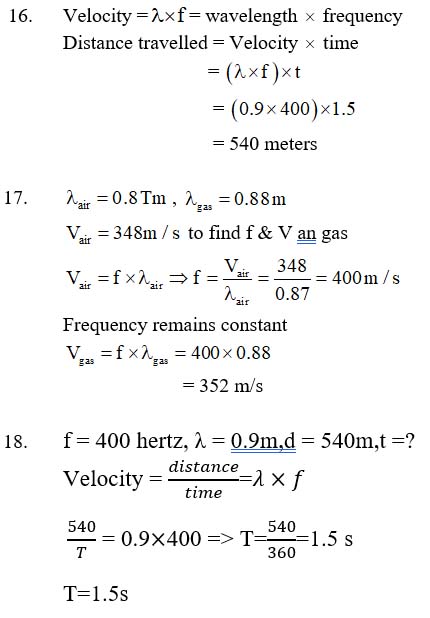
SSC Worksheet for chapter-1 Music of Sound class 9
Worksheet For class 9
Fill in the blanks
- The characteristic of sound that depends on the frequency of sound is its __________ .
- Sound waves cannot propagate in absence of __________ .
- Hertz is the SI unit of __________ .
- In transverse waves, particles of the medium vibrate in direction __________ to the direction of wave propagation.
- __________ sound waves have wide application in medical field, preserving milk, producing images of internal human organs etc.
- The characteristic of sound that enables us to distinguish one sound from the other having some pitch and loudness is __________ .
- __________ of sound is amount of sound energy passing per second through unit area.
- Sound waves are __________ in nature.
- Write a note on range of hearing in humans.
- Write a note on application of ultrasonic sound waves.
- Describe with a neat sketch the human ear and also describe its working.
- Write a note on SONAR.
- Write a note on reverberation.
- Describe how sound propagates in a material medium.
- Describe the following characteristics of sound .
(a) Amplitude
(b) Timbre
(c) Pitch
- A sound wave has frequency 400 Hz and wavelength 0.9 m. How much distance will it cover in 1.5 s?
- A sound wave has wavelength 0.87 m in air and 0.88 m in a gas. Speed of sound in air is 348 m/s. Find frequency of sound and speed of sound in gas.
- A sound wave has frequency 400 Hz and wavelength 0.9 m. How much time does it take to cover 540 m?
For other SSC Worksheet for class 9 Science check out main page of Physics Wallah.
Solutions
1. Pitch
2. Material medium
3. Frequency
4. Perpendicular
5. Ultrasonic
6. Quality or timbre
7. Intensity
8. Longitudinal
16. 540 m
17. 400 Hz, 352 m/s
18. 1.5 seconds
9. Humans can generally hear sounds with frequencies between 20 Hz and 20,000 Hz (the audio range or hearing range) although this range varies significantly with age, occupational hearing damage, and gender. The majority of people can no longer hear 20,000 Hz by the time they are teenagers, and progressively lose the ability to hear higher frequencies as they get older.
10. Application of ultrasonic sound waves:
i) Sonar:
It is low-frequency ultrasonic beam used for underwater observation, communication and navigation in the study of oceanography. The sonar can penetrate deep into the ocean and be reflected back from an obstacle there; thus giving detail underwater information’s. The bottom of the ocean can be mapped properly by using an echo-sounder. The locations and proper positioning of enemy vessels can also be detected using military sonar’s.
(ii) Industry:
In industry ultrasonic waves are widely employed for quality control testing. When a short pulse of ultrasound is sent into a metal, it is immediately reflected back from cracks and blow noise if any present. Along with light, sound wave is used in acoustic holography for advanced technological implications.
(iii) Medicine:
11. For diagnosis of diseases and getting knowledge about internal organs 'ultrasonography ' is used widely in medical science at present time. This technique is mostly employed to locate and define brain tumors, to locate the position of placenta and" fetus during pregnancy, to detect stones in gall bladder and kidneys and to identify the site and severity of arterial obstruction. The instrument used for these purposes is "ultrasonoscope”.
12. Different sounds, produced in our surroundings are collected by pinna that sends these sounds to the ear drum via the ear canal. The ear drum starts vibrating back and forth rapidly when the sound was fall on it. The vibrating eardrum sets the small bone hammer into vibration.
The vibrations are passed from the hammer to the second bone anvil, and finally to the third bone stirrup. The vibrating stirrup strikes on the membrane of the oval window and passes its vibration to the liquid in the cochiea. This produces electrical impulses in nerve cells. The auditory nerve carries these electrical impulses to the brain. These electrical impulses are interpreted by the brain as sound and we get a sensation of hearing.
13. Sonar is an acronym for Sound Navigation and Ranging. It is an acoustic used to measure the depth, direction, and speed of under-water objects such as submarines and ship weeks with the help of ultrasound. It is also used to measure the depth of seas and oceans. A beam of ultrasonic sound is produced and transmitted by the transuded (it is a device that produces ultrasonic sound) of the SONAR which travels through sea water. The echo produced by the reflection of this ultrasonic sound is detected and recorded by the detector; which is converted into electrical signals. The distance (d) of the under-water object is calculated from the time (t) taken by the echo to return with speed (v) is given by 2d=v×t. This method of measuring distance e is also known as echo ranging.
14. Persistence of sound after the stops producing sound due to repeated reflection is known as reverberation, as the source produces sound it starts travelling in all directions. Once it reaches the wall of a room, it is partly reflected back from the wall. This reflected sound reached the other wall and again gets reflected partly.
Due to this sound can heard even after the source has ceased to prove sound. To reduce reverberations sound must be absorbed as it reaches the walls and the ceiling of a room. Sound absorbing materials like fiberboard rough plastic heavy curtains and cushioned seats to reduce reverberation.
When an object vibrates, these vibrations set the particles of the medium around the object into vibrations. These vibrating particles do not travel all the way from vibrating object to the ear. These vibrating particle s exert a force on the adjacent particles of the medium. As the result of this force, the adjacent particles get displaced from their position of rest. These displaced vibrating particles then disturb their immediate adjacent particles and the process continues in the medium till the sound reaches our ear.
15. (a) Amplitude : The magnitude of the maximum disturbance in the medium on either side of the mean value is called the amplitude of the wave. It is usually represented by the letter A. For sound its unit will be that of density or pressure.
(b) Timbre: The quality or timber of sound is that characteristic which enables us to distinguish one sound from another having the same pitch and loudness. The sound which is more pleasant is said to be of a rich quality.
(c) Pitch: How the brain interprets the frequency of an emitted sound is called the pitch. The faster the vibration of the source, the higher is the frequency and the higher is the pitch. Thus, a high pitch sound corresponds to more number of compressions and rarefactions passing a fixed point per unit time.








